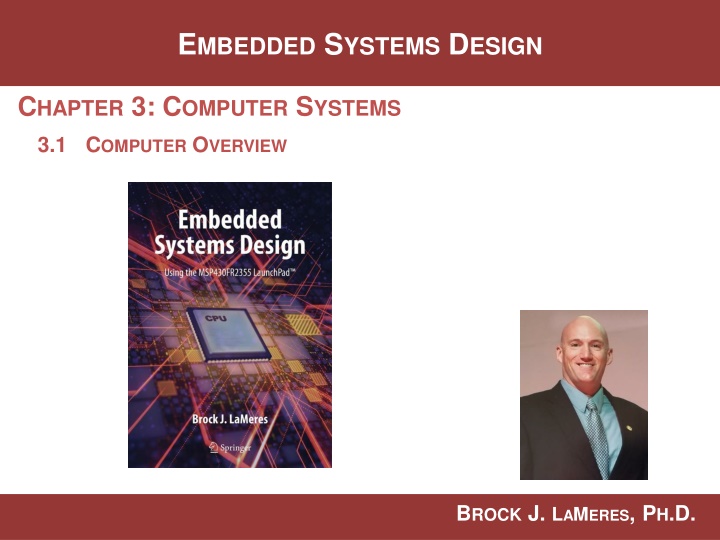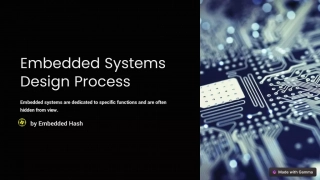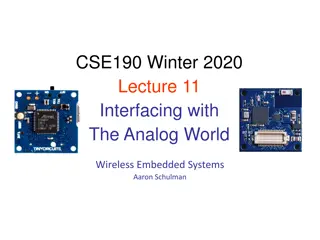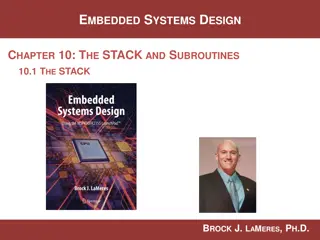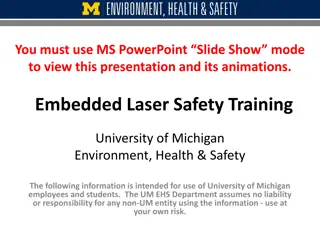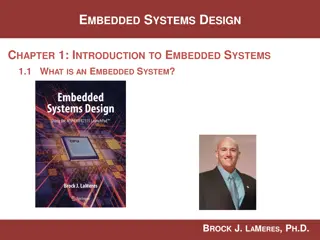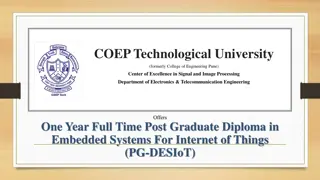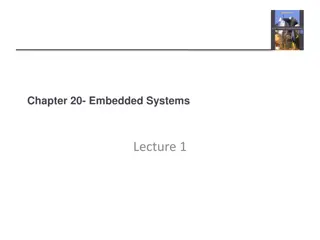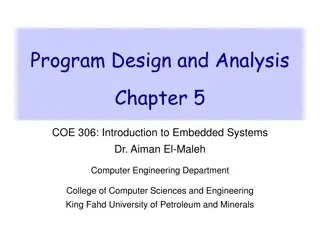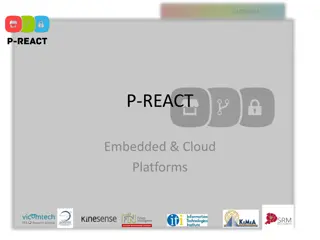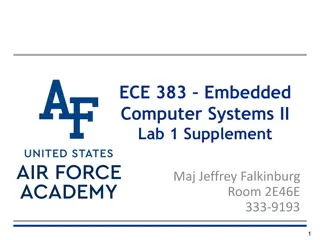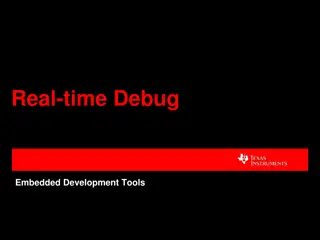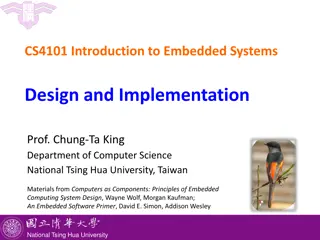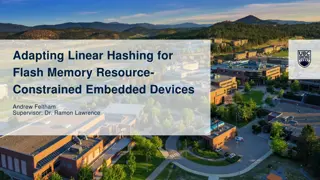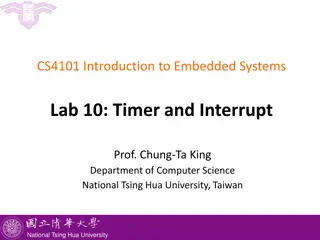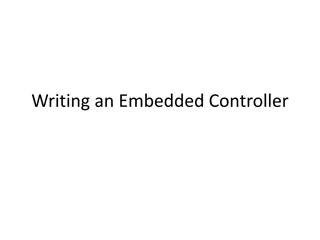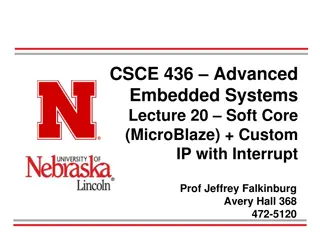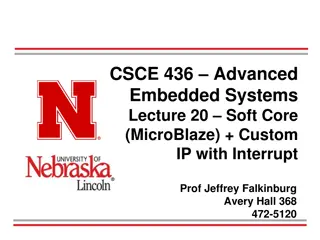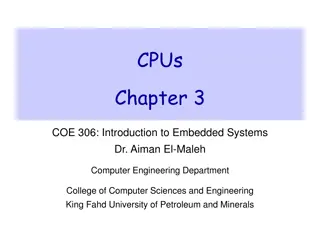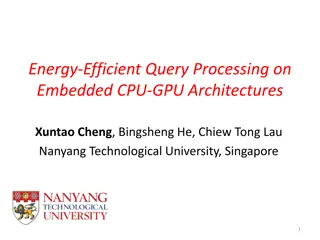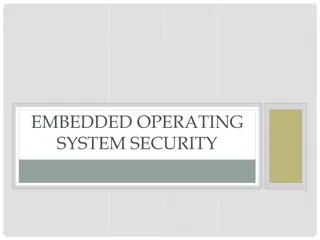EMBEDDED SYSTEMS DESIGN
An in-depth look at computer systems, encompassing hardware and software components crucial for task execution. Delve into definitions of operations, instruction sets, and the roles of software developers and programmers. Understand how hardware provides essential functionality to store and execute programs, alongside facilitating instruction retrieval from memory. Explore computer hardware in detail and gain insights into embedded systems design.
Download Presentation

Please find below an Image/Link to download the presentation.
The content on the website is provided AS IS for your information and personal use only. It may not be sold, licensed, or shared on other websites without obtaining consent from the author.If you encounter any issues during the download, it is possible that the publisher has removed the file from their server.
You are allowed to download the files provided on this website for personal or commercial use, subject to the condition that they are used lawfully. All files are the property of their respective owners.
The content on the website is provided AS IS for your information and personal use only. It may not be sold, licensed, or shared on other websites without obtaining consent from the author.
E N D
Presentation Transcript
EMBEDDED SYSTEMS DESIGN CHAPTER 3: COMPUTER SYSTEMS 3.1 COMPUTER OVERVIEW Image Courtesy of Recording Connection of Canada BROCK J. LAMERES, PH.D.
CHAPTER 3: COMPUTER SYSTEMS COMPUTER DEFINITIONS Computer collection of hardware and software working together to accomplish a task. Image Courtesy of Recording Connection of Canada Digital Storm Desktop Computer https://www.digitalstorm.com/lumos.asp 3.1 COMPUTER OVERVIEW
CHAPTER 3: COMPUTER SYSTEMS COMPUTER DEFINITIONS Computer collection of hardware and software working together to accomplish a task. Operation code (op-code) a binary code that identifies the instruction. Instruction set a group of instructions the computer is designed to execute. Digital Storm Desktop Computer https://www.digitalstorm.com/lumos.asp 3.1 COMPUTER OVERVIEW
CHAPTER 3: COMPUTER SYSTEMS COMPUTER DEFINITIONS (CONT.) Software the sequence of instructions that when executed one-by-one, will accomplish a task. Program the sequence of instructions perform the task. Software developer / programmer a person who designs the program by deciding which instruction and in what order to use. Image Courtesy of Recording Connection of Canada Digital Storm Desktop Computer https://www.digitalstorm.com/lumos.asp 3.1 COMPUTER OVERVIEW
CHAPTER 3: COMPUTER SYSTEMS COMPUTER DEFINITIONS Hardware - provides all the necessary functionality to store the program, retrieve the individual instructions from memory, and execute them. - Refers to the physical components within the system. Image Courtesy of Recording Connection of Canada PCB Unlimited Printed Circuit Boards https://www.pcbunlimited.com/blog/in-case-you-didnt-know- printed-circuit-boards-are-in-almost-everything/ Digital Storm Desktop Computer https://www.digitalstorm.com/lumos.asp 3.1 COMPUTER OVERVIEW
EMBEDDED SYSTEMS DESIGN CHAPTER 3: COMPUTER SYSTEMS 3.1 COMPUTER OVERVIEW www.youtube.com/c/DigitalLogicProgramming_LaMeres BROCK J. LAMERES, PH.D.
EMBEDDED SYSTEMS DESIGN CHAPTER 3: COMPUTER SYSTEMS 3.2 COMPUTER HARDWARE Image Courtesy of Recording Connection of Canada BROCK J. LAMERES, PH.D.
CHAPTER 3: COMPUTER SYSTEMS 3.2 COMPUTER HARDWARE
CHAPTER 3: COMPUTER SYSTEMS 3.2.1 PROGRAM MEMORY The storage system that holds the instruction. Most computers implement program memory on an EEPROM can be read from during normal operations but can only be written to using a dedicated procedure. Treated as read only memory during execution to prevent instructions from being overwritten. Programs stored on non- volatile memory, so the computer system does not lose its program when power is removed. 3.2 COMPUTER HARDWARE
CHAPTER 3: COMPUTER SYSTEMS 3.2.2 DATA MEMORY Used to hold temporary variables that are created by the software program. RAM refers to the data memory of a computer. Can be written to and read from during normal operation. Implemented with read/write memory. Image Courtesy of Recording Connection of Canada 3.2 COMPUTER HARDWARE
CHAPTER 3: COMPUTER SYSTEMS 3.2.3 CENTRAL PROCESSING UNIT Reads instructions from memory, decodes the op-code to determine the instruction is being performed, and executes the necessary steps to complete the instruction. Contains circuitry to perform arithmetic and logic operations on data. Contains registers that are used for general purpose data storage, operational information, and system status. Image Courtesy of Recording Connection of Canada 3.2 COMPUTER HARDWARE
CHAPTER 3: COMPUTER SYSTEMS 3.2.3 CENTRAL PROCESSING UNIT 3.2.3.1 CONTROL UNIT Finite state machine that controls the operation of the computer by fetching the instruction, decoding the instruction op-code, and executing the appropriate steps to accomplish the functionality of the instruction. Image Courtesy of Recording Connection of Canada 3.2 COMPUTER HARDWARE
CHAPTER 3: COMPUTER SYSTEMS 3.2.3 CENTRAL PROCESSING UNIT 3.2.3.2 REGISTERS Execute instructions and hold status information. Dedicated Registers used as part of the normal operation of the computer and are not under the control of the program. General-purpose Registers used by the program as needed. Image Courtesy of Recording Connection of Canada 3.2 COMPUTER HARDWARE
CHAPTER 3: COMPUTER SYSTEMS 3.2.3 CENTRAL PROCESSING UNIT 3.2.3.2 REGISTERS (CONT.) Program Counter(PC) holds the address of the next instruction in program memory to execute. Image Courtesy of Recording Connection of Canada 3.2 COMPUTER HARDWARE
CHAPTER 3: COMPUTER SYSTEMS 3.2.3 CENTRAL PROCESSING UNIT 3.2.3.2 REGISTERS (CONT.) Program Counter(PC) holds the address of the next instruction in program memory to execute. Stack Pointer (SP) provides a way to dynamically allocate variable space in the data memory without having to keep track of specific addresses. Image Courtesy of Recording Connection of Canada 3.2 COMPUTER HARDWARE
CHAPTER 3: COMPUTER SYSTEMS 3.2.3 CENTRAL PROCESSING UNIT 3.2.3.2 REGISTERS (CONT.) Status Register (SR) contains flags that are asserted when various conditions occur during the execution of the program. Image Courtesy of Recording Connection of Canada 3.2 COMPUTER HARDWARE
CHAPTER 3: COMPUTER SYSTEMS 3.2.3 CENTRAL PROCESSING UNIT 3.2.3.2 REGISTERS (CONT.) Status Register (SR) contains flags that are asserted when various conditions occur during the execution of the program. Instruction Register (IR) holds the op-code/operand that is fetched from program memory. Image Courtesy of Recording Connection of Canada 3.2 COMPUTER HARDWARE
CHAPTER 3: COMPUTER SYSTEMS 3.2.3 CENTRAL PROCESSING UNIT 3.2.3.2 REGISTERS (CONT.) General Purpose Registers can be accessed directly by the program. Image Courtesy of Recording Connection of Canada 3.2 COMPUTER HARDWARE
CHAPTER 3: COMPUTER SYSTEMS 3.2.3 CENTRAL PROCESSING UNIT 3.2.3.3 ARITHMETIC LOGIC UNIT (ALU) The system that performs all mathematical and logic operations. Contains logic to produce status bits that provide the ability for subsequent instructions to react to particular results. Image Courtesy of Recording Connection of Canada 3.2 COMPUTER HARDWARE
CHAPTER 3: COMPUTER SYSTEMS 3.2.4 INPUT / OUTPUT PORTS Port hardware component used to access the outside world; can be input, output, or bidirectional. Serial ports use a single line and send data bit-by-bit. Input / Output ports designed to pass information in parallel or serial format. Parallel ports pass data as a bus and allow more information to be transferred per instruction. Image Courtesy of Recording Connection of Canada 3.2 COMPUTER HARDWARE
CHAPTER 3: COMPUTER SYSTEMS 3.2.5 BUS SYSTEM Handles routing of signals between the CPU and memory. I/O ports, data memory, and program memory share the address and data busses. Image Courtesy of Recording Connection of Canada 3.2 COMPUTER HARDWARE
CHAPTER 3: COMPUTER SYSTEMS 3.2.5 BUS SYSTEM (CONT.) Memory Address Bus (MAB) provides a single address to data memory, program memory, and the I/O ports. Memory map gives all the addresses for all locations in memory. Memory Data Bus (MDB) carries information back and forth between the CPU and the memory & I/O ports. Image Courtesy of Recording Connection of Canada 3.2 COMPUTER HARDWARE
EMBEDDED SYSTEMS DESIGN CHAPTER 3: COMPUTER SYSTEMS 3.2 COMPUTER HARDWARE www.youtube.com/c/DigitalLogicProgramming_LaMeres BROCK J. LAMERES, PH.D.
EMBEDDED SYSTEMS DESIGN CHAPTER 3: COMPUTER SYSTEMS 3.3 COMPUTER SOFTWARE Image Courtesy of Recording Connection of Canada BROCK J. LAMERES, PH.D.
CHAPTER 3: COMPUTER SYSTEMS 3.3 COMPUTER SOFTWARE
CHAPTER 3: COMPUTER SYSTEMS RISC VS. CISC RISC(Reduced Instruction Set Computer) Small number of instructions. CISC (Complex Instruction Set Computer) Large number of instructions. 3.3 COMPUTER SOFTWARE
CHAPTER 3: COMPUTER SYSTEMS RISC VS. CISC RISC(Reduced Instruction Set Computer) Small number of instructions. CISC (Complex Instruction Set Computer) Large number of instructions. Increased physical size of the computer. Reduces the size of the needed circuitry in the CPU. Executes instructions very quickly . Executes instructions very quickly. Requires fewer number of instructions to accomplish a given task. Requires a large number of operations to accomplish a given task. 3.3 COMPUTER SOFTWARE
CHAPTER 3: COMPUTER SYSTEMS 3.3.1 CLASSESOF INSTRUCTIONS 3.3.1.1 DATA MOVEMENT INSTRUCTIONS Move information between the CPU and memory or between two memory locations. Do not use the ALU. Assert control signals within the bus system to facilitate the routing and storing of information between a source and destination. 3.3 COMPUTER SOFTWARE
CHAPTER 3: COMPUTER SYSTEMS 3.3.1 CLASSESOF INSTRUCTIONS 3.3.1.2 DATA MANIPULATION INSTRUCTIONS Use the ALU to perform arithmetic or logical operations on information. Examples: addition, subtraction, ANDs, XORs, increments, decrements, bit-sets, and bit-clears. 3.3 COMPUTER SOFTWARE
CHAPTER 3: COMPUTER SYSTEMS 3.3.1 CLASSESOF INSTRUCTIONS 3.3.1.3 PROGRAM FLOW INSTRUCTIONS Provide the ability to alter the program counter to support looping and conditional statement functionality. Unconditional program flow always change the program counter to a fixed value. Conditional program flow only alter the program counter when certain conditions exist within the status register. 3.3 COMPUTER SOFTWARE
CHAPTER 3: COMPUTER SYSTEMS 3.3.2 OP-CODES Unique binary code given to each instruction in the set. Mnemonic a descriptive name for the op-code that can be used when discussing the instruction functionally. Assembly low-level language that uses mnemonics to communicate which instruction is being talked about. Assembler translates the mnemonics and additional information for each instruction into its specific op-code. Image Courtesy of https://neodem.wp.horizon.ac.uk/ Image Courtesy of Recording Connection of Canada 3.3 COMPUTER SOFTWARE
CHAPTER 3: COMPUTER SYSTEMS 3.3.2 OPERANDS Provides additional information needed to complete the instruction. May include moving/copying information: From memory into any of the general-purpose CPU registers. From any CPU register into memory. Between any two CPU registers. Between any two memory locations. Image Courtesy of https://neodem.wp.horizon.ac.uk/ Image Courtesy of Recording Connection of Canada 3.3 COMPUTER SOFTWARE
CHAPTER 3: COMPUTER SYSTEMS 3.3.2 OP-CODESAND OPERANDS Image Courtesy of https://neodem.wp.horizon.ac.uk/ Image Courtesy of Recording Connection of Canada 3.3 COMPUTER SOFTWARE
CHAPTER 3: COMPUTER SYSTEMS 3.3.2 OP-CODESAND OPERANDS Image Courtesy of https://neodem.wp.horizon.ac.uk/ Image Courtesy of Recording Connection of Canada 3.3 COMPUTER SOFTWARE
CHAPTER 3: COMPUTER SYSTEMS 3.3.2 OP-CODESAND OPERANDS Image Courtesy of https://neodem.wp.horizon.ac.uk/ Image Courtesy of Recording Connection of Canada 3.3 COMPUTER SOFTWARE
CHAPTER 3: COMPUTER SYSTEMS 3.3.3 PROGRAM DEVELOPMENT FLOW At the highest level of program development, the language C can be used to develop programs without needing to understand the architecture of the CPU or how the internal registers are used to move and manipulate data. Complier used to convert high-level programming constructs into individual assembly language instructions. Image Courtesy of https://neodem.wp.horizon.ac.uk/ Image Courtesy of Recording Connection of Canada 3.3 COMPUTER SOFTWARE
CHAPTER 3: COMPUTER SYSTEMS 3.3.3 PROGRAM DEVELOPMENT FLOW (CONT.) In assembly language programming, each instruction is listed in a file using the mnemonic with the associated operands. Additionally, information can be provided in an assembly file that will dictate memory allocation for variables. Assembler used to translate the instruction mnemonics and operands into their corresponding binary codes. Image Courtesy of https://neodem.wp.horizon.ac.uk/ Image Courtesy of Recording Connection of Canada 3.3 COMPUTER SOFTWARE
CHAPTER 3: COMPUTER SYSTEMS 3.3.3 PROGRAM DEVELOPMENT FLOW (CONT.) Linker a tool within the development flow that joins multiple source files and assigns the final addresses for the program code. The output of the linker stage is an executable object file that is ready to be downloaded to the MSP430 using the EEPROM programmer. Debugger a tool that allows the program to be executed instruction-by-instruction (stepped) and the values within the CPU registers and memory to be observed as instructions are executed Image Courtesy of https://neodem.wp.horizon.ac.uk/ Image Courtesy of Recording Connection of Canada 3.3 COMPUTER SOFTWARE
CHAPTER 3: COMPUTER SYSTEMS 3.3.3 PROGRAM DEVELOPMENT FLOW Image Courtesy of Recording Connection of Canada 3.3 COMPUTER SOFTWARE
CHAPTER 3: COMPUTER SYSTEMS 3.3.3 PROGRAM DEVELOPMENT FLOW Image Courtesy of Recording Connection of Canada 3.3 COMPUTER SOFTWARE
EMBEDDED SYSTEMS DESIGN CHAPTER 3: COMPUTER SYSTEMS 3.3 COMPUTER SOFTWARE www.youtube.com/c/DigitalLogicProgramming_LaMeres BROCK J. LAMERES, PH.D.
